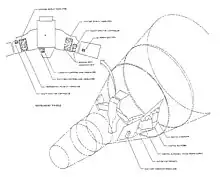Gemini Guidance Computer
The Gemini Guidance Computer (sometimes Gemini Spacecraft On-Board Computer (OBC)) was a digital, serial computer designed for Project Gemini, America's second human spaceflight project.[3] The computer, which facilitated the control of mission maneuvers, was designed by the IBM Federal Systems Division.[4]
.JPG.webp) Gemini Guidance Computer in National Air and Space Museum | |
| Invented by | IBM Federal Systems Division |
|---|---|
| Manufacturer | IBM Federal Systems Division |
| Introduced | 1965 |
| Discontinued | 1966 |
| Type | Avionics Guidance Computer |
| Processor | Discrete Components [1] |
| Frequency | 7.143 kilohertz clock |
| Memory | 39-bit words memory, each composed of three 13-bit syllables, 4096 words of memory, in a ferrite core array. |
| Ports | Modular Display Keyboard (MDK), Modular Display Readout (MDR), Attitude Control and Maneuver Electronics (ACME), Inertial Measurement Unit (IMU), Horizon Sensors, Time Reference System (TRS)[2] |
| Weight | 58.98 pounds (26.75 kg) |
| Dimensions | 18.9"(H)×14.5"(W)×12.75"(D) |
Functionality

Project Gemini was the first with an on-board computer, as Project Mercury was controlled by computers on Earth.[5] The Gemini Guidance Computer was responsible for the following functions:[4][3]
- Ascent – serves as a backup guidance system. The switchover is manually controlled by the astronauts
- Orbital flight – gives the astronauts the capacity to navigate, allowing them to choose a safe landing spot in an emergency and calculate the timing of retrofire. (on extended missions ground data may become unavailable when ground data network rotates out of the orbital plane.)
- Rendezvous – serves as primary reference by providing guidance information to the astronauts. The orbit parameters are determined by the ground tracking which are then sent to the spacecraft; the guidance computer was responsible for processing the information along with sensed spacecraft attitude. The information was presented to the astronauts in terms of spacecraft coordinates.
- Reentry – feeds commands directly to the reentry control system for automatic reentry or provides the guidance information to the astronauts for manual reentry.
Specs
- The computer was architecturally similar to the Saturn Launch Vehicle Digital Computer, in particular in the instruction set;[6] however its circuit integration was less advanced.[7] The GGC weighed 58.98 pounds (26.75 kg) and was powered by 28V DC. During a short power outage it could be powered by the Auxiliary Computer Power Unit (ACPU)
- 39-bit words memory, each composed of three 13-bit syllables[6]
- Ferrite core memory of 4096 words[8]
- Two's complement integer arithmetic
- 7.143 kilohertz clock (140 us per instruction); all instructions took a single cycle except for multiplication and division
See also
References
- "Ch1-2".
- "The Gemini Spacecraft Computer".
- McDonnell Corporation, NASA Project Gemini Familiarization Manual, 1965, vol. 2, pp. 8.7,8.45.
- 8. J. C. Hundley and R. A. Watson, "A Digital Computer in Orbital Flight," TR 63-825-892, IBM Federal Systems Division, Owego, New York, October 1964.
- Tomayko, James E. (1988). "The Gemini Digital Computer: First Machine in Orbit". Computers in Spaceflight: The NASA Experience. Washington, D.C.: National Aeronautics and Space Administration. Retrieved 2015-01-04.
- "Gemini Spacecraft Computer (OBC): Layout of Memory Words". 2016 [2011]. Archived from the original on 2016-05-28. Retrieved 2016-05-28.
- LVDC board reverse engineering project
- Computers in Spaceflight: The NASA Experience, chapter one
External links
As of this edit, this article uses content from "Gemini Guidance Computer", which is licensed in a way that permits reuse under the Creative Commons Attribution-ShareAlike 3.0 Unported License, but not under the GFDL. All relevant terms must be followed.
